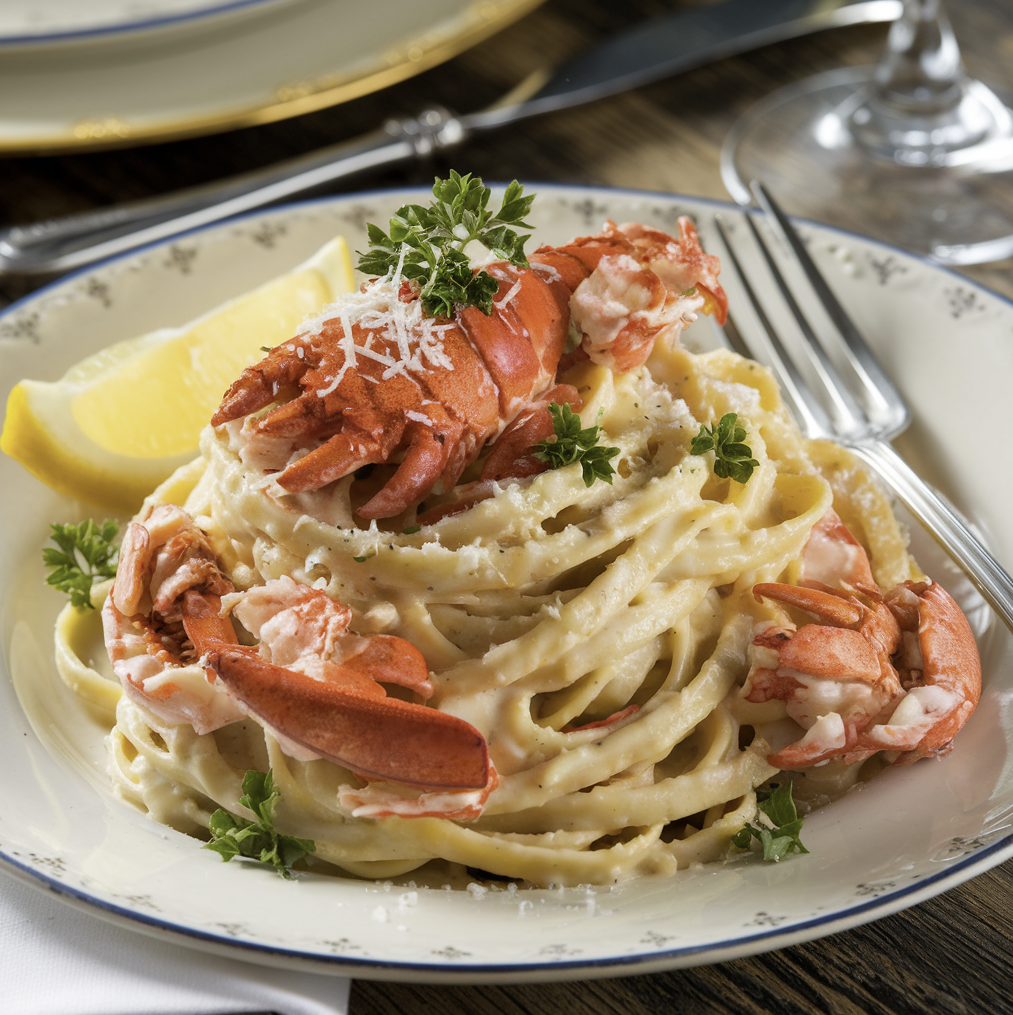Introduction
If you’re looking to impress your dinner guests or treat yourself to a luxurious meal, lobster pasta is a dish that never fails to deliver. Combining the sweet, succulent flavor of fresh lobster with a creamy, flavorful sauce and perfectly cooked pasta, this recipe is the definition of indulgence. Whether you’re a seasoned chef or a beginner in the kitchen, you can create this gourmet dish in your own home with a few simple steps. Ready to dive in? Let’s start cooking the ultimate lobster pasta.
Ingredients for Lobster Pasta

Fresh Lobster: How to Choose the Best
The star of this dish is, of course, the lobster. Fresh lobster provides the best texture and flavor. When selecting your lobster, make sure it’s alive and lively—this indicates it’s fresh. The shell should be hard, which means the lobster is mature and has more meat.
Essential Ingredients for the Sauce
- 2 fresh lobsters (about 1.5 lbs each)
- 12 oz of pasta (fettuccine or linguine work best)
- 1 cup heavy cream
- 2 cloves garlic, minced
- 1 shallot, finely chopped
- 1 cup lobster stock (optional but highly recommended)
- 1/4 cup grated Parmesan cheese
- Fresh parsley, chopped for garnish
- Salt and pepper to taste
- Lemon wedges for serving
Optional Add-ons to Elevate the Dish
- Red pepper flakes for a touch of heat
- Fresh basil for added freshness
- Sun-dried tomatoes for a deeper flavor profile
Tools You’ll Need
Cooking Equipment for a Perfect Lobster Pasta
- A large pot for boiling the lobster and pasta
- Tongs and kitchen scissors for handling the lobster
- A skillet for making the sauce
- A colander to drain the pasta
Time-saving Kitchen Tools
- An immersion blender to blend the sauce to a smoother texture, if desired
- A pasta fork for easy tossing
Preparing the Lobster
How to Properly Cook a Lobster
Cooking lobster can seem intimidating, but it’s actually quite simple. You can either steam or boil the lobster depending on your preference.
Boiling vs. Steaming: Which is Better?
Boiling is faster, but steaming ensures that the lobster retains more of its natural flavor. For this recipe, I recommend steaming the lobster for about 12 minutes, until the shell turns bright red.

Removing the Lobster Meat: A Step-by-Step Guide
- Once cooked, let the lobster cool slightly.
- Use kitchen scissors to cut through the shell.
- Gently pull out the lobster meat, being careful not to tear it.
- Chop the meat into bite-sized pieces and set aside.
Preparing the Pasta
Choosing the Right Type of Pasta
Fettuccine or linguine is ideal for this dish because the flat shape holds the sauce beautifully.
Fresh vs. Dry Pasta: Which is Best for Lobster?
While fresh pasta offers a softer texture, dry pasta is sturdier and holds up better when combined with the rich lobster sauce. Both options are great, so choose based on your personal preference.
Cooking the Pasta to Al Dente Perfection
Cook the pasta in salted boiling water for about 8-10 minutes or until it’s al dente. The texture should be firm yet tender.
Creating the Creamy Lobster Sauce
The Secret to a Velvety Lobster Sauce
The key to a perfect lobster sauce is using lobster stock. It adds depth and enhances the lobster flavor throughout the dish.
Using Lobster Stock for Extra Flavor
If you don’t have pre-made lobster stock, you can make it by simmering the lobster shells with garlic, onion, and herbs for about 30 minutes. Strain and use this flavorful liquid in the sauce.
Herbs and Spices to Enhance the Sauce
A simple combination of garlic, shallots creates a beautiful base. Add in some fresh parsley and a squeeze of lemon to brighten up the flavors.
Combining the Lobster and Pasta
Once the sauce is ready and the pasta is cooked, it’s time to bring everything together. Gently toss the pasta in the creamy lobster sauce and add the cooked lobster meat. Make sure everything is evenly coated.
Adding Finishing Touches: Fresh Herbs, Lemon, and Parmesan
Finish the dish with fresh parsley, a sprinkle of Parmesan cheese, and a squeeze of lemon for a burst of freshness.
Common Mistakes to Avoid
Overcooking the Lobster
Overcooked lobster turns rubbery and tough, so be sure to monitor your cooking time carefully.
Undercooking the Pasta
Cooking the pasta too quickly can leave it mushy. Al dente is the texture you’re aiming for.
Oversaucing: Why Less is More
You want the sauce to complement the lobster and pasta, not overpower it. Add sauce gradually and stop when it coats the pasta lightly.
Serving Suggestions
Best Side Dishes for a Complete Meal
Garlic bread, a simple green salad, or roasted vegetables make excellent sides.
Storing and Reheating Lobster Pasta
How to Store Leftovers Without Losing Flavor
Place any leftovers in an airtight container and refrigerate for up to two days.
Reheating Tips for Keeping the Lobster Tender
To reheat, warm the pasta slowly on the stovetop over low heat. Add a splash of cream or water to loosen the sauce if necessary.
Variations of Lobster Pasta
Spicy Lobster Pasta for Heat Lovers
Add a pinch of red pepper flakes to the sauce for a spicy kick.
Garlic Butter Lobster Pasta: A Classic Twist
Swap the cream sauce for a garlic butter sauce for a simpler, yet equally delicious version.
Health Benefits of Lobster
Nutritional Value of Lobster
Lobster is low in fat and high in protein, making it a healthy choice for seafood lovers.
Why Lobster is a Healthy Protein Option
In addition to being a great source of lean protein, lobster is rich in omega-3 fatty acids, which are good for heart health.
Conclusion
Lobster pasta is the ultimate indulgence, combining the rich flavors of lobster with a creamy, flavorful sauce and perfectly cooked pasta. It’s a dish that feels luxurious


1 thought on “The Ultimate Lobster Pasta Recipe”
Comments are closed.